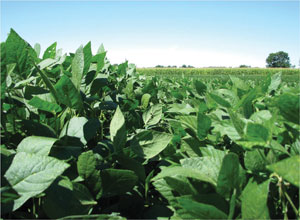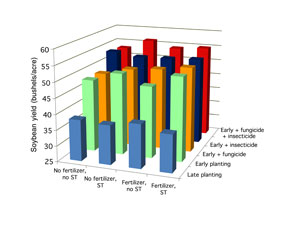
Features
Agronomy
Soybeans
Achieving gains in soybean yields
Is more intensive management worth it?
February 21, 2009 By Heather Hager
Since the early 1990s, the potential yield of soybean “has increased by about one percent per year based on side-by-side comparisons of today’s varieties with those that came on the market 15 years ago,” says Dr. Dave Hume, University of Guelph professor emeritus and crop consultant for Agri-Trend Agrology Ltd. “However, in that same time period, average Ontario soybean yields seem to have plateaued around the 36 to 40 bu/ac mark, with the exception of two wet years.” In contrast, the 2007 US record holder for soybean yield produced 154.7 bu/ac of intensively managed, irrigated soybean in Missouri. Is this high level of production an anomaly or is more intensive soybean management really worth the effort?
The soybean crop has generally received minimal inputs, especially when compared to a crop like corn. “In the past, there’s been a widespread opinion that soybeans are relatively easy to grow and need few inputs,” explains Horst Bohner, soybean specialist with the Ontario Ministry of Agriculture, Food and Rural Affairs (OMAFRA). “The idea of just planting and spraying and then leaving them alone until harvest was the way it was done 20 years ago.”
 |
|
Despite visual differences during the growing season, there was little yield response to phosphorus and potassium fertilizer at this site. Advertisement
|
Recent issues with insects and disease have necessitated more management. Nevertheless, Bohner estimates that most soybeans in Ontario do not receive a fungicide or insecticide seed treatment. He reckons that about half do not receive an inoculant containing the symbiotic microbes that are necessary for nitrogen fixation, and most do not receive nutrient inputs.
Still, in field experiments, specific treatments have achieved clear increases in soybean yields. Hume cites the addition of phosphorus, potassium, manganese, and inoculants as factors he has studied that can increase soybean yields. There may also be positive effects of rotation, planting date, tillage, insecticides, fungicides, and plant hormones. The challenge is to determine whether the costs of extra inputs will pay off in increases in yield.
In a rotation, the usual management strategy is to feed the corn well and then let the soybean scavenge whatever phosphorus and potassium is left in the field the following year. “My research data say that we’re getting a seven to 10 percent increase in yield from meeting the phosphorus and potassium requirements that the soil tests would say were needed for those soybean varieties and banding it into the soybean field,” says Hume. This effect is especially noticeable in medium- and low-fertility fields and in dry summers. He notes that some growers are going to 30-inch rows to facilitate banding two inches below and beside the seed with the planter.
Research is pointing to an inconsistent response of Roundup Ready soybean to foliar manganese applications. “In 2007, we averaged a seven percent yield response to foliar manganese,” says Hume. “In a 40 bu/ac soybean crop, we’re talking about a 3 bu/ac increase, and that will pay for itself handsomely.” In the wet summer of 2008, there was no response to foliar manganese. In 2007, the effect was not achieved if the glyphosate and manganese were applied together and was best if the manganese was applied 10 days after the herbicide. Banding about 2.5 lbs/ac of manganese at planting time gives the same effect and can be combined with a phosphorus and potassium application.
Hume is also finding small increases in yield with the use of an inoculant, even in fields with a history of soybean. “In our trials, we’ve averaged about 1.5 bu/ac from the HiStick N/T technology compared to just using the older HiStick technology.” If soybean prices are high, the payoff for using an inoculant is improved. “What all this is saying is there are a bunch of little increments out there from sharper management. None of them by themselves are very big, but you start adding threes and threes and twos, and all of a sudden you’re looking at maybe a 10 percent increase in yield,” concludes Hume.
Hume has some other advice gleaned from 35 years of field-testing soybeans. His highest yields have consistently come from early planting and in fields with a history of manure applications, not for the soybean, but rather for corn or wheat crops earlier in the rotation.
New research looks at synergies and economics
In Ontario, a group of partners from the University of Guelph, OMAFRA, and the Ontario Soybean Growers (OSG)is looking at the effects of more intensive soybean management through the Strategic Management Adding Revenue Today, or SMART, project. This three-year project began in 2008. The objective is to use scientific, replicated experiments at both small plot and large field scales to determine which inputs make sense economically. To this end, SMART researchers are evaluating input costs and yield outputs for the standard soybean practice compared to additional management factors that might affect yield. Testing on small, intensive plots is led by Dr. David Hooker, agronomy professor at the University of Guelph Ridgetown campus, and testing at the field scale is led by Bohner, with the aid of participating growers.
Five factors were examined in the first year of the project: planting date, spring pre-tillage, seed treatment, fertilizer, and foliar insect and disease control. “Researchers have typically looked at each factor individually, but this project looks at all five factors together. So we’re looking at synergistic or additive effects of the treatments,” says Hooker. His preliminary results indicate that planting date had the greatest and most consistent effect. “We’ve seen yield responses of 10 bu/ac just by planting early,” he states.
The project targeted early planting dates of the first week of May versus late dates of the last week of May or first week of June; however, the actual early planting dates were the second to third week of May versus late dates of the second week of June because of wet soil conditions in spring of 2008. According to Bohner, on average, Ontario data collected during a number of years indicate a loss of 3.8 bu/ac with a late planting date between May 10 and 27.
Hooker says that yield responses to the other factors in the SMART project were generally positive, but smaller. Spring tillage using nonaggressive tillage equipment such as the Salford RTS system or the Great Plains Turbo Till before planting into no-till achieved a 2 bu/ac increase on average over no-till. Seed treatment with a combination of inoculant, fungicide, and insecticide gave a two bushel per acre average increase over no treatment. A combination of broadcast and seed-placed phosphorus and potassium gave a 1.5 bu/ac average increase over no fertilizer. The amount of fertilizer added was based on the amounts of phosphorus and potassium used by a 50 bu/ac crop of soybean: 40 and 70 lbs/ac, respectively. In contrast, the response to foliar insect and disease control was highly variable. “It just depends on whether there are insects or diseases,” says Hooker. “We can get up to a 15 bu/ac response.” He estimates an economic response that pays for the application as about a 3.2 bu/ac increase. Hooker is currently analyzing how the different inputs interact.

|
| Preliminary results from one of the intensive small-plot trials in 2008. A very late planting during the second week of June reduced yields by an average of 10 bu/ac compared to earlier planting during the third week of May. Seed treatment (ST) with insecticide, fungicide, and inoculant increased yields by 2 bu/ac only for the early planting. There was little response to phosphorus and potassium fertilizer at this site. Foliar insecticide produced some yield response by controlling bean leaf beetle. Figure courtesy of Dr. David Hooker, University of Guelph Ridgetown Campus, and Horst Bohner, OMAFRA. |
In the field-scale experiments, some inputs were lumped together to reduce the number of combinations for the sake of practicality, says Bohner. Among the eight test sites, responses to inputs differed depending on the field conditions. For example, fertilizing seemed to produce the greatest response at one site, whereas foliar insecticide and fungicide had the greatest effect at another site because of moderate bean leaf beetle pressure. “When we average across all eight no-till sites, the response is not that exciting,” says Bohner. The best combination of inputs increased the yield by 3.2 bu/ac on average, “and we spent a bunch of money on that treatment,” he states. For conventional tillage, the best yield increase was only 2.8 bu/ac.
And, says Bohner, the economics are not pretty. He estimates the costs per acre in 2008 at $19 for the seed treatment of insecticide and fungicide with inoculant, $79 for seed treatment plus pre-tillage ($15) plus fertilizer ($45), and $103 for the previous inputs plus foliar insecticide and fungicide. For the latter treatment with all inputs, the best yield response was 6.5 bu/ac, and the average response was 3.0 to 4.0 bu/ac. “In 2008, the only input that made sense averaged across all sites was the seed treatment,” says Bohner. “At least it paid for itself.”
Other inputs made money at a few sites, but were not profitable when averaged across all locations. Thus, some paybacks can be achieved if inputs are applied on a field-specific basis according to integrated pest management and agronomic principles.
Bohner and Hooker conclude that the yield responses from the various inputs are not necessarily additive, but it will require more years of study to determine which ones or combinations are the best choices. They state that management decisions will require the consideration of factors such as field conditions and year, e.g., some fields may require fertilizer, others insecticide, and adding inputs without considering that year’s conditions will likely result in money lost. They also note that some inputs can result in a negative response. For example, soil compaction that occurred with pre-tillage in wet soil produced a 5.0 bu/ac loss, so agronomic principles remain important.
In combination with the SMART project, OSG held a soybean yield challenge to recognize high-yielding growers and learn about their management approaches. The highest yields ranged from 69.1 to 72.1 bu/ac for three zones of Ontario classified by heat units. In most areas of Ontario, 2008 was a good year to grow soybean because of abundant rainfall. Important factors suggested by the yield challenge winners were planting early in spring into warm soil, choosing a high-yielding variety, and the use of seed treatments.
There is still work to be done, especially in determining which inputs achieve yield increases that are economically beneficial. Further results from this research will be something to watch for during the next couple of years.